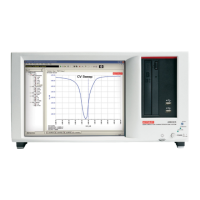3-148 Return to Section Topics 4200-900-01 Rev. K / February 2017
Section 3: Common Device Characterization Tests Model 4200-SCS User’s Manual
The following link to procedures for these UTM and ITM tests:
Running the Program or Erase UTM
Running the Fast-Program-Erase UTM
Running the SetupDC UTM
Running the Vt-MaxGm ITM
Running the ConPin-Pulse or ConPin-DC UTM (Switch projects only)
Running endurance or disturb looping
The Endurance or Disturb testing is essentially a stress / measure test. The stress
portion applied a number of pulse waveforms to the DUT, then periodically
measurements are performed.
1. Double-click FlashSubsite (see red arrow in Figure 3-113), then click the Subsite Setup tab.
The screen should resemble Figure 3-113.
2. Ensure that the Segment Stress / Measure Mode is chosen.
3. Determine the stress intervals and how often the measurements are performed. Each entry
in the Stress Counts box is the number of waveforms that will be output. After the listed
number of waveform counts is output, measurements are preformed. All checked boxes in
the project navigator will be run after each stress interval.
a. Choose Linear, Log or List
b. Enter the First stress count, which must be at least 1.
c. Enter the Total Stress Count, which is the last stress interval output.
d. Number of stresses is the number of stress intervals.
i. For linear, the number of total stress intervals
ii. For log, the number of stress intervals per decade count of stress counts
e. Press the Apply button to see the updated Stress Counts and intervals.
4. Click the Device Stress Properties button, which displays something similar to Figure 3-114.
5. The General Settings show the SMU settings during the stress portion of the test. These
settings are necessary when using an array DUT structure, either direct connect (see Figure
3-96) or using a switch matrix (see Figure 3-97).
a. If a SMU bias is required, then set the voltage and current limit.
b. If using shared cabling, or SMU/VPU pairings, set all Pins entries = -1, to disconnect the
SMUs during the stress, allowing the pulse signals to properly reach the DUT terminals.
c. If using a switch matrix, set the pin connection. If no connection is required, input 0.
6. Pulse generator settings configure the waveforms used during the stress. See Using Kpulse
to create and export Segment ARB waveforms to create the desired multi-level pulse
waveforms.
a. Click the … button for each available pulse channel. Choose the desired waveform,
previously created and exported, from the available list. Each channel must have an
associated .ksf waveform and each waveform should have the same duration.
7. Parameter properties show which parameters are graphed in the Subsite graph, and if any
test should end early. If a test should end after a certain VT shift, either an absolute voltage
shift, or a % shift follow the below:
a. Choose % or Abs.
b. Check the box.
c. Enter the Target value.

